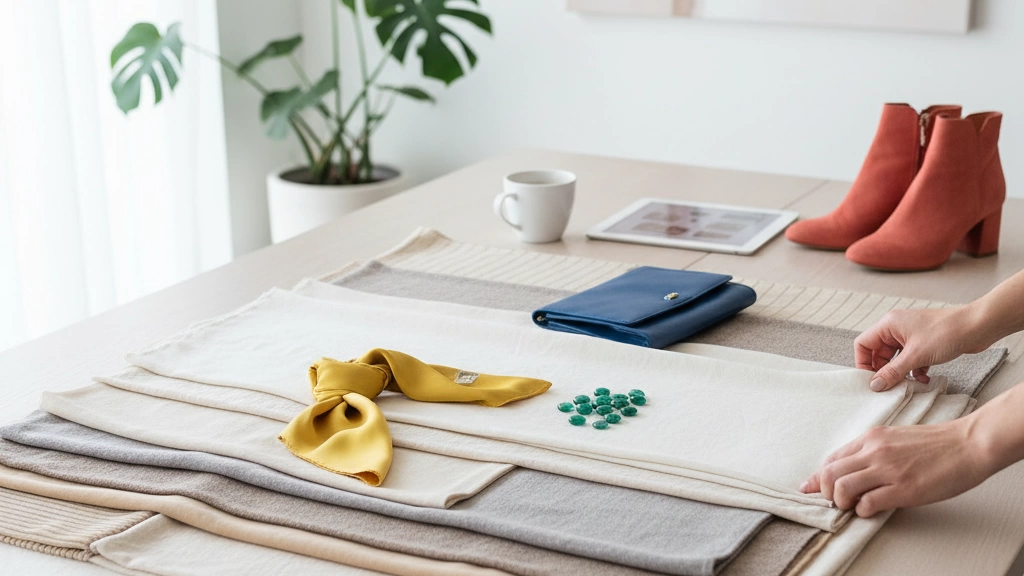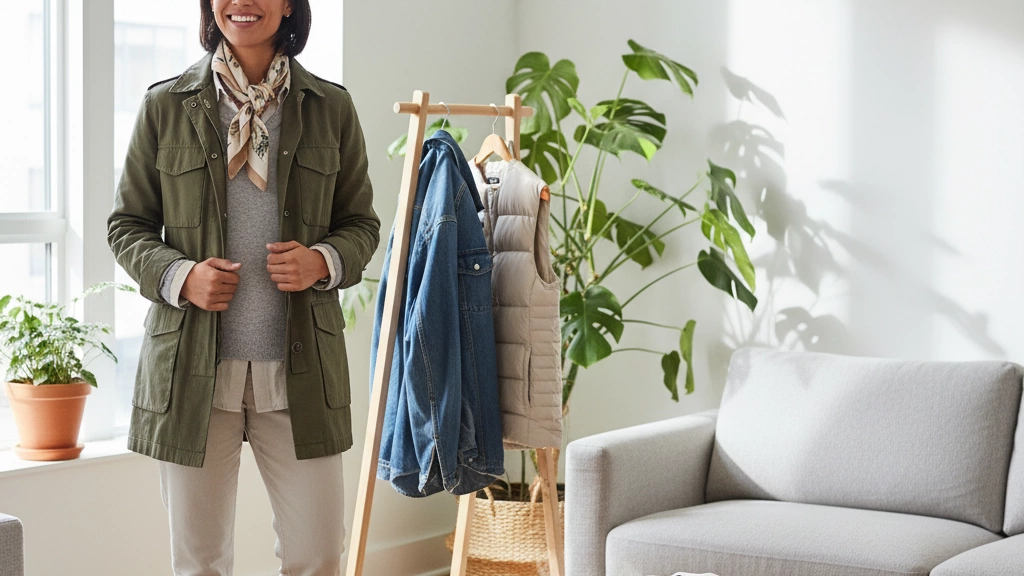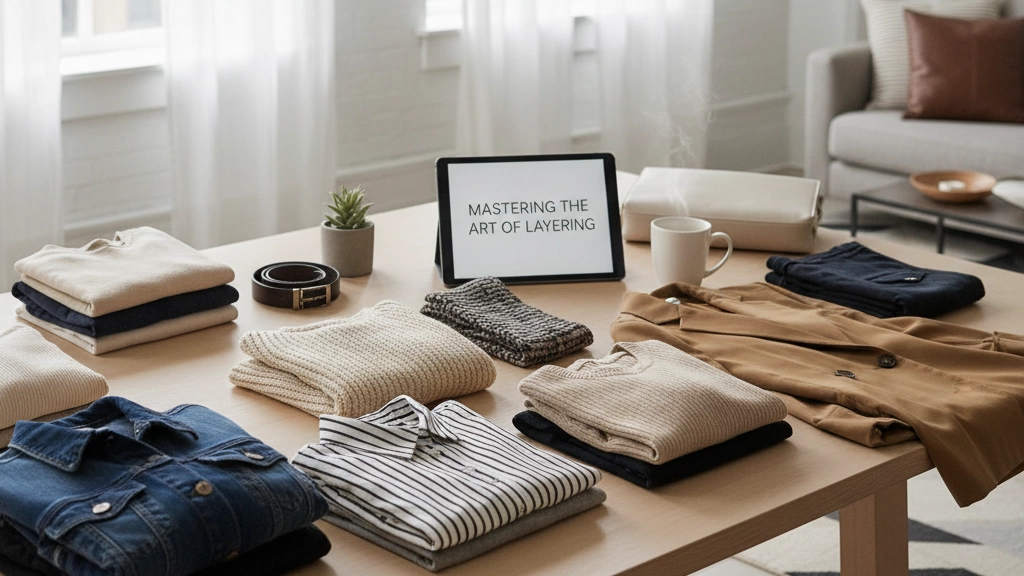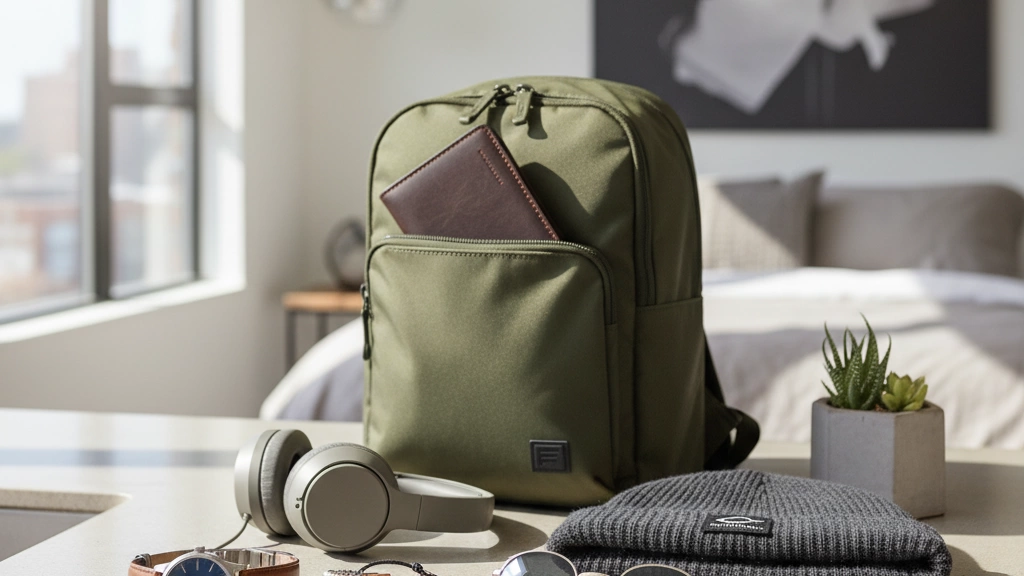Mastering the art of layering isn’t about piling on clothes aimlessly. It’s the secret weapon behind every outfit that looks effortlessly polished and expensive—no matter the season. If you’re ready to go beyond the basics and dive into advanced layering techniques, perfect proportions, and luxe fabric combos, you’re in exactly the right place. This guide will have you wearing layers like a pro, turning simple pieces into a cohesive, elevated look you’ll never want to take off. Let’s get you mastering layering like the style icon you deserve to be.
The Golden Rules of Advanced Layering
Mastering advanced layering begins with understanding a few core principles that keep your outfit balanced, flattering, and effortlessly chic. These rules act as your go-to formula every time you build a look.
The Rule of Thirds & Perfect Proportions
Divide your outfit into three visible sections: top, middle, and bottom. This division creates visual harmony and structure—whether it’s a cropped jacket over a mid-length sweater and full-length pants, or a longline blazer paired with a tucked-in shirt and midi skirt. Keep proportions distinct to avoid looking bulky or shapeless.
The 3-Layer Maximum Rule (and When to Break It)
Generally, stick to three layers for clarity and movement: a base (like a silky blouse), a mid-layer (knitwear or a vest), and an outer layer (blazer or coat). More than three can overwhelm your silhouette, but exceptions exist for colder months—think thin tech fabrics or lightweight accessories that add warmth without bulk.
Length Hierarchy Formula (Short + Medium + Long)
For perfect balance, mix lengths vertically. Combine a short piece (like a cropped jacket), a medium-length layer (button-down shirt or vest), and a long item (trench coat or cardigan). This layering trick elongates your frame and adds depth with ease.
The “Frame the Face” Principle
Always consider what’s closest to your face. Layers around your neckline—scarves, collars, or necklines—should complement your skin tone and highlight your features. Keeping this zone polished ensures your face remains the focal point, not overwhelmed by layers.
Sleeve Length Discipline
Sleeves should never compete. Keep one layer’s sleeves visible and others cropped or tucked. For example, a crisp shirt peeking out from under a blazer sleeve adds polish; bulky sleeves stacked together create a puffy marshmallow effect that’s best avoided.
Master these golden rules, and you’ll layer like a pro—balanced, sophisticated, and effortlessly put-together every time.
Fabric & Texture Play – The Secret to Expensive-Looking Layers
Mastering fabric and texture is key to achieving layers that look rich and put-together. Start with a weight progression from light to medium to heavy: think a silk blouse under a cashmere sweater, topped with a structured wool coat. This creates depth without bulk.
Some of the best luxury texture combos include:
- Cashmere + silk – soft and smooth meets plush warmth
- Wool + leather – classic, sturdy and elegant
- Denim + chiffon – casual edge with a delicate twist
When mixing matte and shine, keep it subtle. Pair a matte wool blazer with a silk or satin cami rather than all-over glossy fabrics, which can look cheap. A light sheen layered over a matte base adds dimension without overpowering.
To avoid the dreaded “puffy marshmallow” effect, avoid doubling up on thick, fluffy fabrics. Instead, balance a chunky knit with sleek, fitted pieces underneath or a streamlined jacket on top. This keeps your silhouette clear and elegant.
For smart layering, fabric choices are just as important as color and cut—play with textures to elevate your look effortlessly. If you want to step up your layering game for transitional weather, checking tips on office-to-evening transitions with one accessory can also help maintain polish throughout your day.
Color Mastery in Layering

Mastering color is key to making your layered outfits look intentional and polished. Start with neutral-on-neutral combinations like beige, camel, gray, black, and ivory. These shades create a sleek, effortless base that\’s easy to build on. For instance, pairing a camel trench with a soft ivory sweater and gray pants keeps things classic but interesting.
Next, dive into monochromatic layering — wearing different shades of the same color from head to toe. It stretches your silhouette and looks super chic. Think various tones of gray from charcoal to dove, or layering blues like navy, denim, and powder blue.
To avoid monotony, add strategic pops of color using the 80/20 rule: keep 80% of your outfit neutral, then add 20% in a bold shade like emerald green, burnt orange, or cobalt blue. A colorful scarf, handbag, or shoes can instantly lift the look without overpowering it.
Also, try the “column of color” technique, where you wear a solid block of color under your layers. For example, a bright red turtleneck beneath a neutral blazer creates a confident and streamlined effect, drawing the eye vertically for a flattering silhouette.
For more tips on adding color thoughtfully, check out this guide on how to add a pop of colour to your wardrobe.
Essential Layering Pieces Every Wardrobe Needs in 2024
To master the art of layering in 2024, you need a solid foundation of versatile pieces that work seamlessly together. Here are the 12 key layering essentials every wardrobe should include:
- Thin merino wool turtlenecks: Lightweight but warm, perfect under blazers or trench coats without bulk.
- Silk button-down shirts: Smooth texture that adds a subtle luxe feel, great for both office and casual layering.
- Tailored vests: Sharpens your silhouette and adds dimension without overheating.
- Longline blazers: Extend your layering options with sleek, elongated cuts that flatter most body types.
- Lightweight trench coats: Ideal for transitional weather, they add polish without the weight.
- Fine-knit crewneck sweaters: Easy to layer over shirts or under jackets, providing warmth and texture.
- Cashmere cardigans: A soft, luxurious mid-layer to elevate any look.
- Straight-leg jeans: A neutral base that balances layered tops without clashing.
- Slim-fit trousers: Perfect for work layering with blazers and fine knits.
- Silk camisoles: Great for layering under sheer blouses or blazers, adding a feminine touch.
- Leather or wool scarves: Adds warmth and anchors layers visually.
- Classic lightweight leather jackets: Adds edge and texture without bulk.
Investing in these pieces lets you mix and match confidently while following advanced layering techniques. For a detailed look at smart accessory layering to complement these essentials, check out this guide on 10 pieces of jewelry every wardrobe needs that style pros swear by.
These items provide the versatility to craft effortless chic layering outfits suitable for fall 2024 and beyond.
Seasonal Layering Masterclasses

Mastering layering means adapting your approach with the changing seasons—here’s how to do it right:
Fall Layering: Light to Heavy Transition
Start with lightweight basics like thin knits or long-sleeve tees, then add medium layers like cardigans or blazers. Finish with a structured coat or trench for warmth. Aim for pieces you can remove as temperatures shift throughout the day.
Winter Layering: Warm but Still Chic
Think insulation without bulk. Use thermal or merino wool base layers combined with cashmere sweaters, topped with a wool coat or leather jacket. Accessories like scarves and gloves not only add warmth but also polish the look. Avoid the “puffy marshmallow” effect by choosing streamlined silhouettes and mixing textures thoughtfully.
Spring Layering: Shedding Without Looking Bulky
Spring’s all about light layers that adapt to unpredictable weather. Pair lightweight trench coats with silk or cotton shirts, and layer on vests or thin sweaters. This keeps you ready for warm afternoons and brisk mornings without feeling heavy.
Unexpected Summer Layering: Evening & Office AC Outfits
Even in summer, layering is key—especially for air-conditioned offices or cooler evenings. Think breathable fabrics like linen or silk cami tops under lightweight blazers or soft cardigans. This lets you maintain a polished look without overheating.
For all seasons, layering is about balance—mix different weights, textures, and colors smartly to stay comfortable and stylish year-round. To complete your seasonal outfits, consider adding subtle jewelry or accessories that can “anchor” your layers, enhancing your overall look without overpowering it. Learn more about why dainty jewelry is still dominating the fashion world to perfect your finishing touches.
20 Copy-Paste Outfit Formulas with Visual Examples
Mastering the art of layering is easier when you have go-to outfit formulas ready. Here are 20 effortless combos for work, weekends, date nights, travel, and casual Fridays—each designed to look polished and chic without overthinking.
Work
- Blazer + thin knit + silk camisole + tailored trousers
A classic combo that layers perfectly with luxury textures—think a soft cashmere knit under a sharp blazer, paired with a silk camisole for a subtle sheen. This formula ensures you stay comfortable yet sophisticated all day.
Weekend
- Oversized shirt + sleeveless sweater + trench coat + straight jeans
Ideal for casual days, this look plays with relaxed fits and lightweight layers. The sleeveless sweater adds warmth without bulk, and the trench keeps it polished, perfect for transitional weather.
Date Night
- Fitted turtleneck + leather skirt + statement belt + heeled boots
Sleek layering focusing on length hierarchy and silhouette, creating an elegant but approachable vibe.
Travel
- Longline blazer + soft tee + comfy joggers + slip-on loafers
Functional layering combining ease and style, with oversized pieces that breathe and move with you while maintaining that \”effortless chic layering\” look.
Casual Friday
- Denim jacket + printed blouse + cropped trousers + ankle boots
Balancing casual with structure, this outfit uses texture mixing fashion smartly, using denim against delicate prints for good contrast.
Each formula follows core layering principles like the 3-layer maximum, mix of matte and shine, and color mastery (try neutral layers with strategic pops of color). For more insight on mixing textures and layering fabrics, check out our practical fabric mixing guide and elevate your looks without much effort.
Having these formulas on standby makes dressing for any occasion intuitive while keeping your look fresh and expensive-looking.
Advanced Techniques the Stylists Don’t Share
Mastering the art of layering means knowing the subtle tricks stylists use but rarely spill. One of the hottest debates is the half-tuck vs French tuck for layered outfits. The half-tuck adds a casual vibe, perfect for weekend looks, while the French tuck gives clean lines and balance, ideal for office layering.
Another pro move is the belt-over-layers trick. Cinching a belt over a blazer or cardigan instantly shapes your silhouette and adds polish, especially when layering bulky pieces.
For the bold, double blazer layering is a fashion-forward way to amp up your outfit. Layer a thinner blazer under a heavier one to give depth and a modern edge.
Don’t overlook the power of accessories: a scarf as a third piece not only boosts warmth but also frames your face and adds texture. Speaking of accessories, using jewelry to “anchor” floating layers is a secret worth trying. Statement necklaces or chunkier chains help ground loose or oversized layers, preventing your outfit from looking shapeless. For ideas on jewelry styles that complement layered looks, check out this guide on minimalist jewelry styling.
These advanced layering techniques elevate your outfits from good to effortlessly chic.
Common Layering Mistakes Even Fashion Girls Make
Even the most stylish know that layering can go wrong if you’re not careful. Here are the 8 biggest mistakes to avoid for effortlessly chic layering:
- Bulky under bulky: Stacking thick pieces without thinking clogs your silhouette and adds unwanted volume. Instead, balance a heavy outer layer with lighter inner fabrics.
- Ignoring proportions: Mixing oversized with oversized rarely works. Stick to the length hierarchy formula (short + medium + long) to keep your look polished.
- Too many logos: Overbranding ruins the luxurious feel of layered outfits. Keep logos subtle or go logo-free for an expensive look.
- Wrong sleeve lengths: Sleeves that bunch or disappear inside layers look messy. Follow sleeve length discipline for clean lines.
- Clashing textures: Don’t pile on all heavy or all shiny fabrics—mix matte and shine thoughtfully to avoid cheap vibes.
- Overdoing color: Layering multiple bright colors without a plan creates visual chaos. Use the 80/20 rule for pops of color.
- Skipping the “frame the face” step: Your first visible layer around the neck and shoulders should flatter and highlight your features.
- Neglecting fit under layers: Too-tight or too-loose pieces under outerwear can ruin comfort and style.
Check out before/after examples to see how fixing these mistakes instantly upgrades your layering game. For styling tips on anchoring layers, you might find insights in guides about understated elegance in jewelry, which can also help with tying your look together without clutter.
Avoid these traps to master the art of layering like a pro!
How to Layer for Your Body Type
Layering isn’t one-size-fits-all. Your body shape changes how layers look and feel, so tailoring your approach is key to mastering the art of layering.
Petite
- Stick to fewer layers to avoid overwhelming your frame.
- Opt for thin, fitted fabrics that won’t add bulk.
- Use the length hierarchy formula (short + medium + long) to create height illusion.
- Try monochromatic layering or the “column of color” technique to elongate your silhouette.
Tall
- Play with more volume—tall bodies can handle additional layers without looking bulky.
- Incorporate longline pieces like blazers and trenches to complement your height.
- Break up your frame with patterns or contrasting textures to avoid looking too linear or boxy.
Curvy
- Focus on defining your waist using belts over layers or tailored vests.
- Avoid anything too bulky around the midsection; instead, opt for structured layers that skim your shape.
- The “frame the face” principle can draw attention upward, balancing your overall look.
Apple
- Choose layers that add structure to your shoulders and neckline, like fitted blazers or lightweight trench coats.
- Avoid too many heavy or bulky layers midsection-wise, to prevent a “puffy marshmallow” effect.
- Use vertical lines and open layering to elongate your torso and create flow.
Athletic
- Layer to add shape and softness—try mixing contrasting textures like leather and chiffon to create curves.
- Use layering pieces like tailored vests and fitted turtlenecks to add definition.
- Sleeve length discipline is essential—opt for layers that show off your arms without overwhelming them.
For more on accessorizing layers perfectly, check out our guide on how to match your earrings to anchor your look with the right jewelry. Layering well for your body type not only boosts your style but also your confidence.



